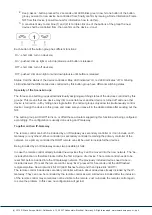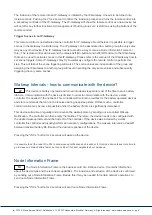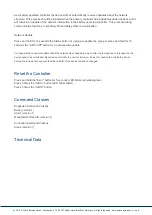
The inclusion of the remote into an IP-Gateway is initiated by the IP-Gateway. It needs to be turned into
inclusion mode. Pushing 'Incl.' for 2 second confirms the inclusion process and turns the remote control into
a secondary controller of the IP-Gateway. The IP-Gateway will show the remote control as a new device but
will not offer any further functions. All management of button groups etc. is still done using the buttons of the
remote control!
Trigger Scenes in an IP-Gateway
This remote control is no dedicated scene controller for IP-Gateways. Nevertheless it is possible to trigger
scenes in the Gateway in a limited way. The IP gateway can be associated to a button group the very same
way as any other device (The IP Gateway needs to provide a way to issue a Node Information Frame for
this.). The remote control will now send the values 0xff (On button) and 0x00 (Off button) to the IP-Gateway
that can be used to activate scenes in this IP-Gateway. Please refer to the manual of the IP-Gateway how to
set scene triggers. Some IP-Gateways may try to wirelessly configure the remote control to perform this
step. This will fail but the scene triggering still works. The scene values are independent of the group and
assigning the IP-Gateway to another group will result in sending the very same values and subsequently
triggering the very same scenes.
Wakeup Intervals - how to communicate with the device?
W
This device is battery operated and turned into deep sleep state most of the time to save battery
life time. Communication with the device is limited. In order to communicate with the device, a static
controller C is needed in the network. This controller will maintain a mailbox for the battery operated devices
and store commands that can not be received during deep sleep state. Without such a controller,
communication may become impossible and/or the battery life time is significantly decreased.
This device will wakeup regularly and announce the wakeup state by sending out a so called Wakeup
Notification. The controller can then empty the mailbox. Therefore, the device needs to be configured with
the desired wakeup interval and the node ID of the controller. If the device was included by a static
controller this controller will usually perform all necessary configurations. The wakeup interval is a tradeoff
between maximal battery life time and the desired responses of the device.
Pressing the "INCL." button for 2 seconds will wake up the device.
It is possible to set the node ID to 255 to send wakeup notifications as broadcast. In this mode device takes more time to
go to sleep and drains battery faster, but can notify all it's direct neighbors about a wakeup.
Node Information Frame
NI
The Node Information Frame is the business card of a Z-Wave device. It contains information
about the device type and the technical capabilities. The inclusion and exclusion of the device is confirmed
by sending out a Node Information Frame. Beside this it may be needed for certain network operations to
send out a Node Information Frame.
Pressing the "INCL." button for 2 seconds will send out a Node Information Frame.
(c) 2012 Z-Wave Europe GmbH, Goldbachstr. 13, 09337 Hohenstein-Ernstthal, Germany, All rights reserved, www.zwaveeurope.com - pp 5









